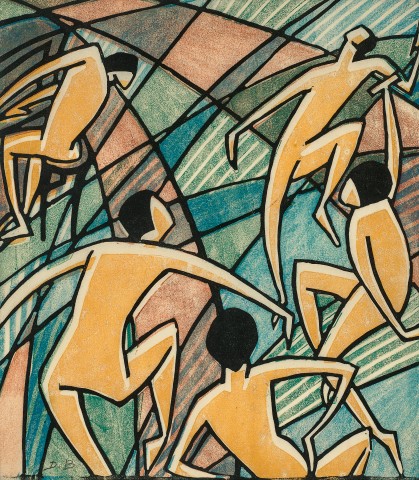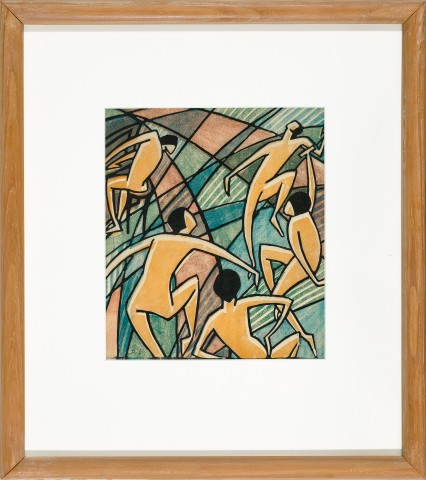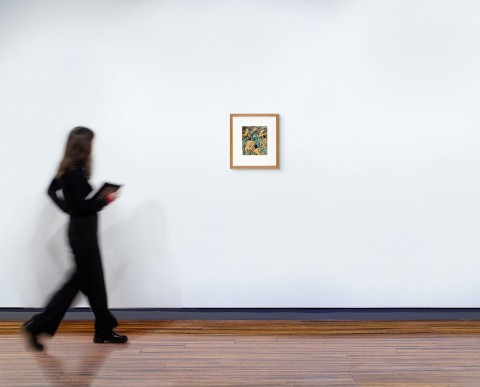MUSIC, 1927 - 28
DORRIT BLACK
colour linocut on thin cream oriental laid paper printed from five blocks in black, yellow, ochre, brick red, grey-green and cobalt blue
24.0 x 21.5 cm (image)
31.0 x 24.5 cm (sheet)
signed with initials lower left: D.B.
inscribed with title and numbered in margin upper left: Music 10/50
Private collection
Deutsher Galleries, Melbourne
Private collection, Canada, acquired from the above in March 1978
Thence by descent
Private collection, Canada
First Exhibition of British Lino-cuts, Redfern Gallery, London, 4 – 27 July 1929, cat. 49 (another example)
Painting and Sculpture by A Group of Seven, Macquarie Galleries, Sydney, 26 March – 5 April 1930, cat. 6 (another example)
Work by Members of the Arts and Crafts Society of Victoria, Town Hall, Melbourne, 13 – 24 October 1931 (another example)
Exhibition of Oils, Watercolours and Lino Cuts by Dorrit Black, Royal South Australian Society of Arts, Adelaide, 7 – 23 July 1938, cat. 31 (another example)
The Drawing, Print and Watercolour Exhibition, Contemporary Art Society of Australia, Melbourne, opened 2 December 1952, cat. 14 (another example)
Dorrit Black 1891 – 1951, Art Gallery of South Australia, Adelaide, then touring, Art Gallery of New South Wales, Sydney; Newcastle Region Art Gallery, New South Wales; The Ewing and George Paton Galleries, University of Melbourne, Melbourne, 1975 – 76, cat. 50 (another example)
A Survey of Australian Relief Prints 1900 – 1950, Deutscher Galleries, Melbourne, 13 April – 5 May 1978
Art Deco and works from the period, S.H. Ervin Gallery, Sydney, 16 June – 14 July 1980 (another example)
Project 39 – Women's Imprint, Art Gallery of New South Wales, Sydney, 1 – 31 October 1982 (another example)
Claude Flight and his Followers: The Colour Linocut Movement between the Wars, Australian National Gallery, Canberra, 18 April – 12 July 1992, cat. 17 (another example)
Modernism 1900 - 1950: prints and drawings from the collection, Art Gallery of New South Wales, Sydney, 23 July – 25 September 1994 (another example)
Review: Works by Women from the permanent collection of the Art Gallery of New South Wales, Art Gallery of New South Wales, Sydney, 8 March – 4 June 1995 (another example)
Art Deco: from Sydney Cinemas and Pubs to Skyscrapers, Museum of Sydney, Sydney, 12 June – 5 September 1999 (another example)
Dorrit Black Collection, Josef Lebovic Gallery, Sydney, 17 April – 29 May 1999, cat. 1 (another example)
Modern Australia Women: Paintings and Prints 1925 – 1945, Art Gallery of South Australia, Adelaide, 24 November 2000 – 25 February 2001; then touring to the Art Gallery of Western Australia, Perth, the National Gallery of Australia, Canberra, the S.H. Ervin Gallery, Sydney and the Art Gallery of Ballarat, Victoria (another example)
The Story of Australian Printmaking, National Gallery of Australia, Canberra, 30 March – 3 June 2007 (another example)
Australian Collection Focus: Colour, Rhythm, Design - wood & lino cuts of the 20s & 30s, Art Gallery of New South Wales, Sydney, 12 March – 11 July 2010 (another example)
Professor Sadler, Japan and Australian modernism, University Art Gallery, University of Sydney, Sydney, 3 April – 24 July 2011 (another example)
Dorrit Black 1891 – 1951, Royal South Australian Society of Arts, Adelaide, 24 April – 15 May 2011, cat. 9 (another example)
Sydney Moderns, Art Gallery of New South Wales, Sydney, 6 July – 7 October 2013 (another example)
Dorrit Black: Unseen Forces, Art Gallery of South Australia, Adelaide, 14 June – 7 September 2014 (another example)
Modern impressions; Australian prints from the collection, Art Gallery of New South Wales, Sydney, 2 September 2016 – January 2017 (another example)
Cutting Edge: Modernist British Printmaking, Dulwich Picture Gallery, London, 19 June – 8 September 2019 (another example)
Art & linoleum cut out pictures with umbrella ribs', Sun, Sydney, 16 March 1930, p. 8 (illus., another example)
Butler, R., and Deutscher, C., A Survey of Australian Relief Prints 1900/1950, Deutsher Galleries, Melbourne, 1978, p. 92 (illus., another example)
North, I., The Art of Dorrit Black, Art Gallery of South Australia, Adelaide, and Macmillan, South Melbourne, 1979, cat. L.1, pl. 5, pp. 27 (illus., another example), 131
Waldmann, A., Project 39 – Women's Imprint, Art Gallery of New South Wales, Sydney, 1982, np.
Edwards et al., Review: Works by Women from the Permanent Collection of the Art Gallery of New South Wales, Art Gallery of New South Wales, Sydney, 1995, n.p.
Coppel, S., Linocuts of the Machine Age: Claude Flight and the Grosvenor School, Scolar Press, Aldershot, 1995, pp. 66, 152 (illus., another example), pl. 31, cat. DBI
Topliss, H., Modernism and Feminism, Australian Women Artists 1900 – 1940, Craftsman House, Sydney, 1996, p. 142 (illus., another example)
Hylton, J., Modern Australian Women: Paintings & Prints 1925 – 1945, Art Gallery of South Australia, Adelaide, 2000, p. 25 (illus., another example)
Butler, R., Printed Images by Australian Artists 1885 – 1955, National Gallery of Australia, Canberra, 2007, p. 205 (illus., another example)
Campbell, H., Colour, Rhythm, Design: Wood & Lino cuts of the 20s & 30s, Art Gallery of New South Wales, Sydney, 2010, pp. 2, 16 (illus., another example)
Mimmocchi, D., Sydney Moderns: Art for a New World, Art Gallery of New South Wales, Sydney, 2013, pp. 79, 178 (illus., another example), 310, 320
Grishin, S., Australian Art: A History, The Miegunyah Press, Melbourne, 2015, p. 232, pl. 23.4 (illus., another example)
Lock-Weir, T., Dorrit Black: Unseen Forces, Art Gallery of South Australia, Adelaide, 2014, pp. 8 – 9 (illus., another example), 154 (illus., another example), 199 (illus., another example)
Samuel et al., Cutting Edge: Modernist British Printmaking, Dulwich Picture Gallery, London, 2019, pp. 15, 16 (illus.), 39, 40, 49, 70, 74, 90 (illus.) and illus. back cover (another example)
230468 nla news page_cmyk.jpg
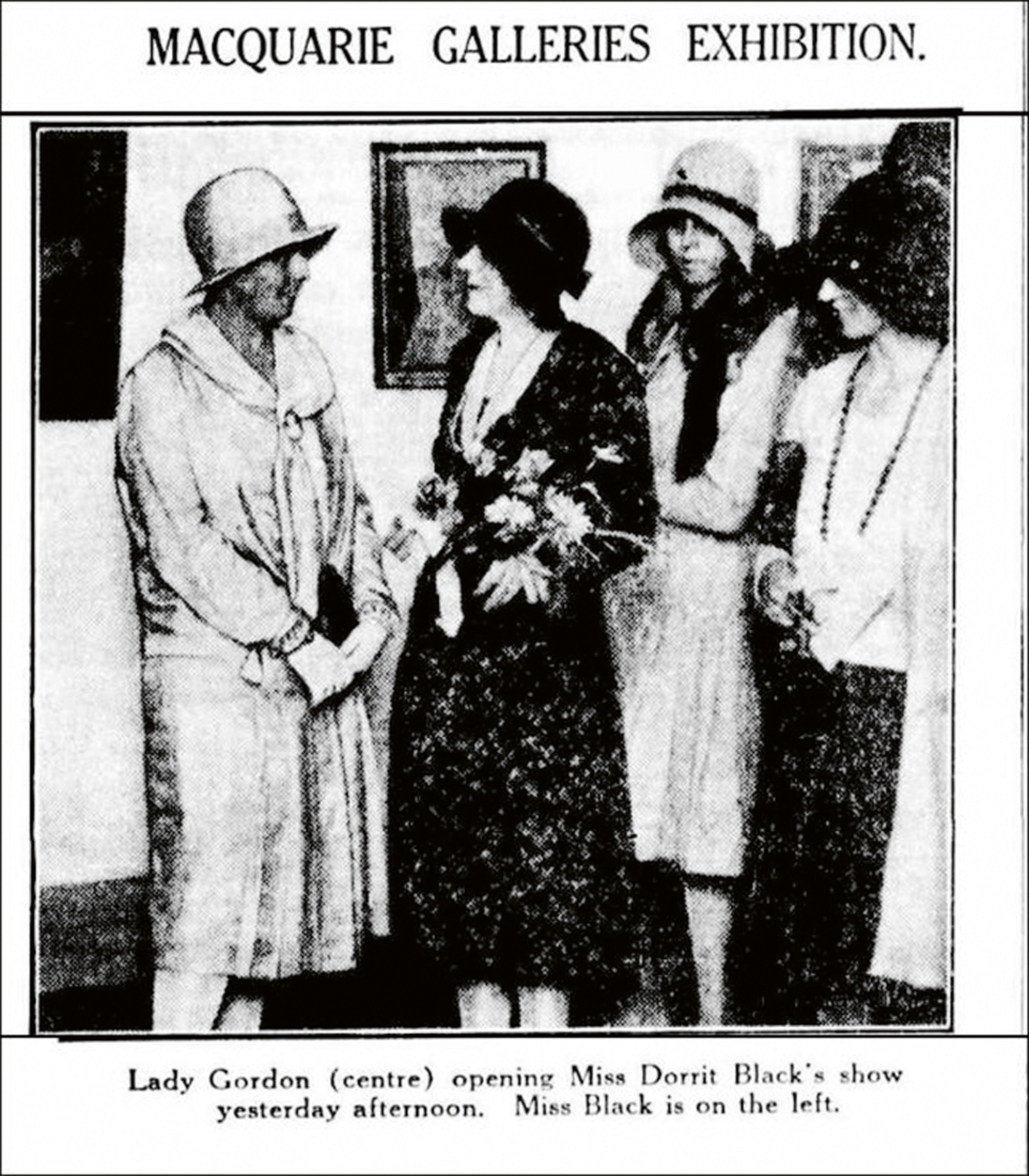
Miss Black's show.
Miss Black is on the left.
Sydney Morning Herald, Sydney,
11 September 1930
Adelaide-born Dorrit Black began her studies at the South Australian School of Arts and Crafts around 1910, moving to Sydney in 1915 where she attended Julian Ashton’s Sydney Art School. In England in late 1927, she studied for several months at London’s Grosvenor School of Modern Art, and later in France sought out other progressive teachers – André Lhote, who introduced her to Cubism and Albert Gleizes, who offered ‘a bridge from Cubism to pure abstraction: from the static to the dynamic.’1 Armed with this firsthand knowledge of developments in contemporary international art, when Black returned to Australia at the end of 1929 she joined the ranks of a small group of female artists, including Grace Crowley, Anne Dangar, and earlier, Margaret Preston, who, through the exhibition of their art, sometimes teaching – and in Black’s case, her energetic proselytising – played a critical role in the introduction and spread of approaches to modern art in Australia.
230468 Book _cmyk.jpg
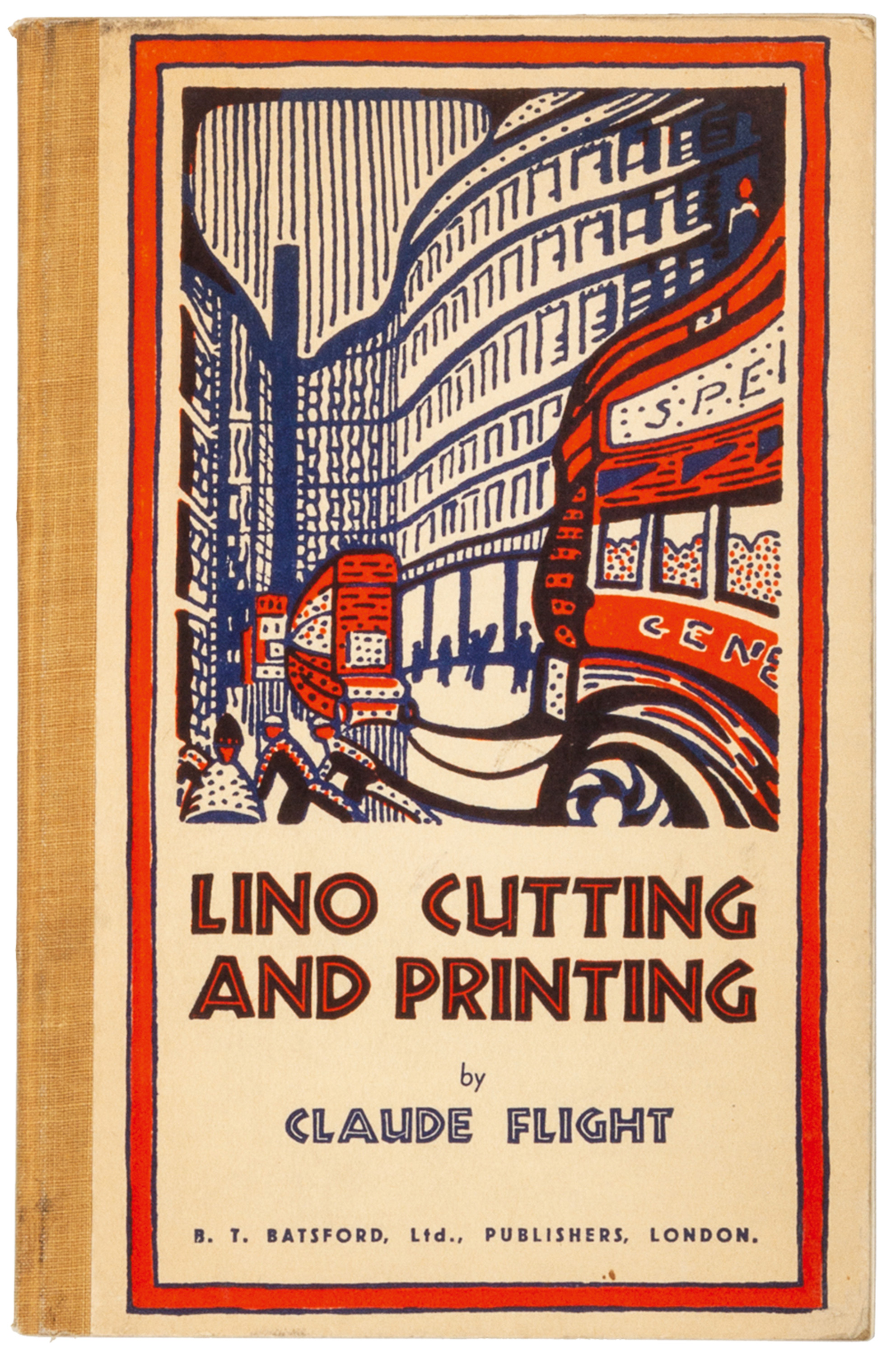
cutting and printing
Douglas Stewart Fine Books
While Black’s first introduction to the linocut technique was probably through Thea Proctor in Sydney during the early 1920s,2 the most significant influence on her work in the medium was Claude Flight. Teaching at the Grosvenor School from 1926 – 30, he revolutionised printmaking in the 1920s and 30s through his passionate advocacy of the colour linocut, regarding it as the modern medium for the modern age. His 1927 book, Lino-Cuts. A Hand-Book of Linoleum-Cut Colour Printing (1927), was the first major publication on the subject and quickly became the standard manual used by artists across the world. Although Black only studied with Flight for a few months, she absorbed his example of the use of bold colour, the reduction of subject matter to simplified shapes, and patterns based on a dynamic system of opposing rhythmic lines and forms.
One of the earliest colour linocuts Black made after her encounter with Flight, Music, 1927 – 28 clearly reflects his influence in its strong design and lively sense of movement, and the master approved, writing to Black after seeing a trial proof, ‘I think it very good. I especially like the person at the piano… I think you have got away with the idea very well… I believe that rather abstract ideas work better in Lino-cuts than definite views.’3 Indeed, Flight’s admiration for this print was such that he included it, along with four others by the Australian artist, in the first of the regular exhibitions of colour linocuts that he organised at the Redfern Gallery in London in 1929.4
230468 Art + Linoleum.jpg
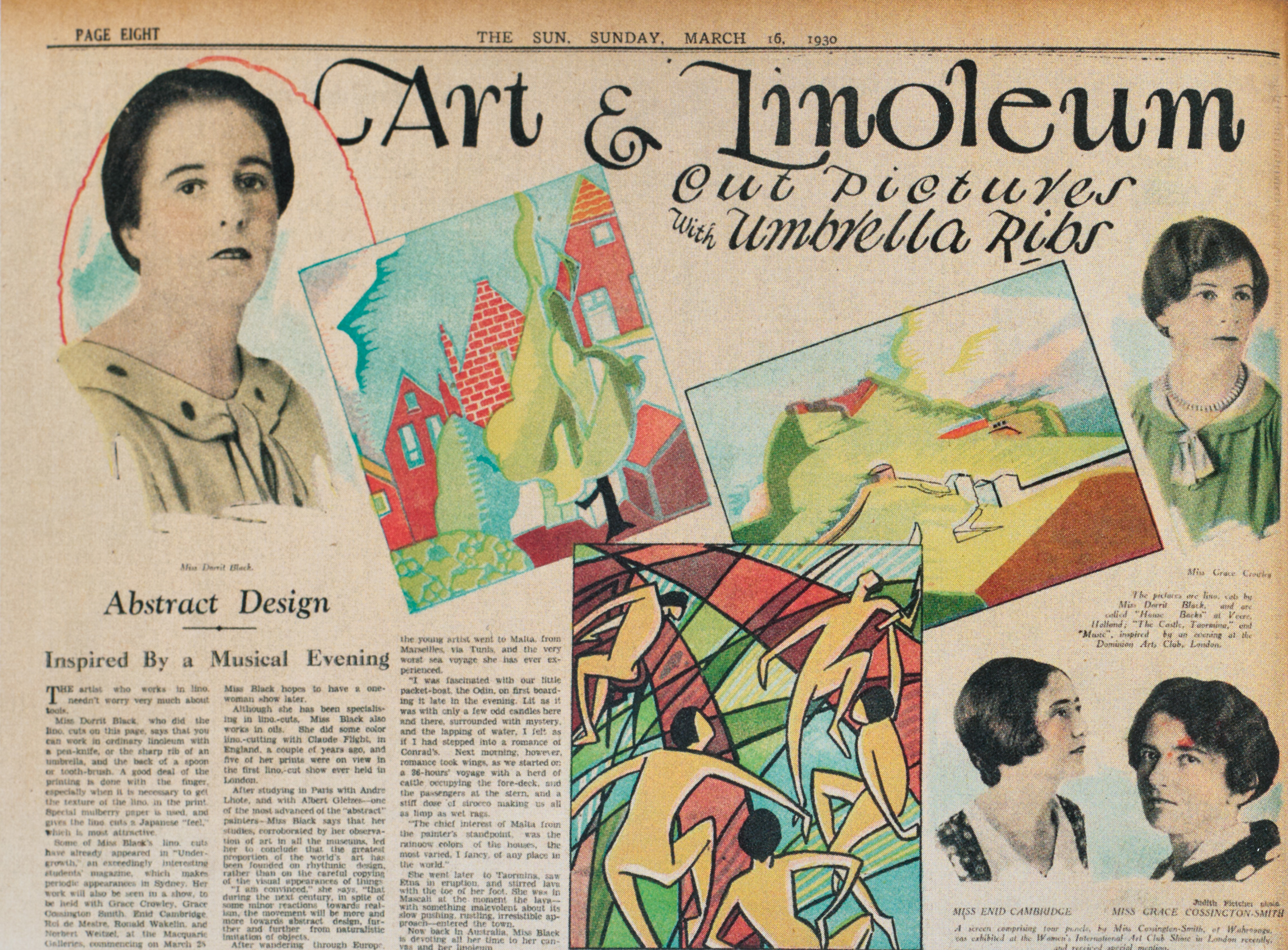
The image was inspired by a jazz evening at the Dominion Arts Club in London and the dynamism of the composition, with its sweeping arcs of background line, colour and pattern, and the stylised dancing figures, gives vivid expression to the energy and excitement of the experience. Printed on delicate cream paper in five colours – black first, followed by yellow ochre, red-brown, grey-green and blue – from five separate linoblocks, this impression is inscribed with the edition number 10/50, however as was often the case with relief prints (linocuts and woodcuts) by Australian artists at the time, it is unlikely that the entire edition was ever completed. Other catalogued impressions of Music are held in the collections of the Art Gallery of New South Wales, the Art Gallery of South Australia and the National Gallery of Australia.
1. Lock-Weir, T., Dorrit Black: Unseen Forces, exhibition catalogue, Art Gallery of South Australia, Adelaide, 2014, p. 56
2. Freak, E., ‘The Modern Medium: Colour Linocuts’ in Lock-Weir, ibid., pp. 144 – 145
3. Claude Flight, letter to Dorrit Black, 25 March 1928, cited in Lock-Weir, ibid., p. 36 and Coppel, S., Linocuts of the Machine Age: Claude Flight and the Grosvenor School, Scolar Press in association with the National Gallery of Australia, Aldershot, 1995, p. 66
4. The other prints by Black included in the Redfern Gallery exhibition were The Acrobats, 1927 – 28; Wings, 1927 – 28; The Castle, Taormina, c.1929; and Argentina, c.1929.
KIRSTY GRANT
